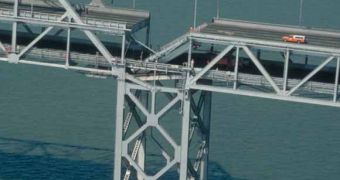Everybody knows the famous robot dance. Well, it seems that the next generation of bridges will dance on a different beat, the earthquake dance.
A group of researchers made up mostly of earthquake engineers at the University at Buffalo and MCEER, funded by the U.S. Federal Highway Administration, have reached the conclusion that bridges capable of performing dance-like moves in the rhythm of the quakes could be the safest and least expensive to build, retrofit and repair.
An intensive study of the various vibrations occurring during an earthquake has produced the first seismic design methodology for building bridge towers that react to ground motions by literally jumping a few inches off the ground.
This method has been successfully tested on a 20 feet high, 9 tons tower model. They used a shake table allowing six degrees of freedom in UB's Structural Engineering and Earthquake Simulation Laboratory (SEESL).
"Our approach is unconventional, counterintuitive," admits Michel Bruneau, Ph.D., director of MCEER and UB professor of civil, structural and environmental engineering, who developed the new approach with Michael Pollino, a doctoral candidate in the UB Department of Civil, Structural and Environmental Engineering. "With an earthquake, conventional wisdom dictates that the most important thing is to anchor the bridge tower," explained Bruneau. "The mass wants to overturn, so you have to tie it down."
Instead of anchoring the bridge with expensive foundation materials that subject the bridge to the full force of the earthquake, they used a design that disconnected the legs of the truss tower from the foundation and briefly uplifted them nearly 4 inches in the air for less than a second when important ground movement was detected.
"In this scenario, something usually has to yield," he says. "Here, we're standing that concept on its head. By letting the tower rock, we're significantly reducing the overturning force."
The device, known as hysteretic or viscous dampers, could have important applications in the construction of highly resistant bridges that could withstand even the most powerful earthquakes.

 14 DAY TRIAL //
14 DAY TRIAL //